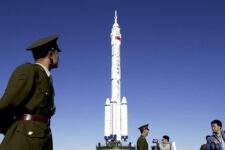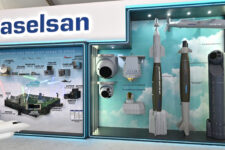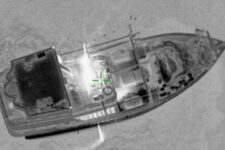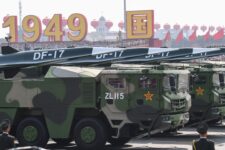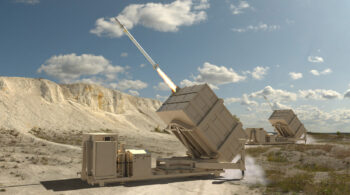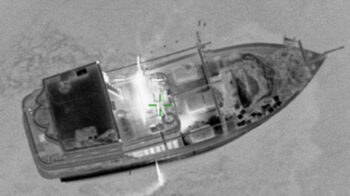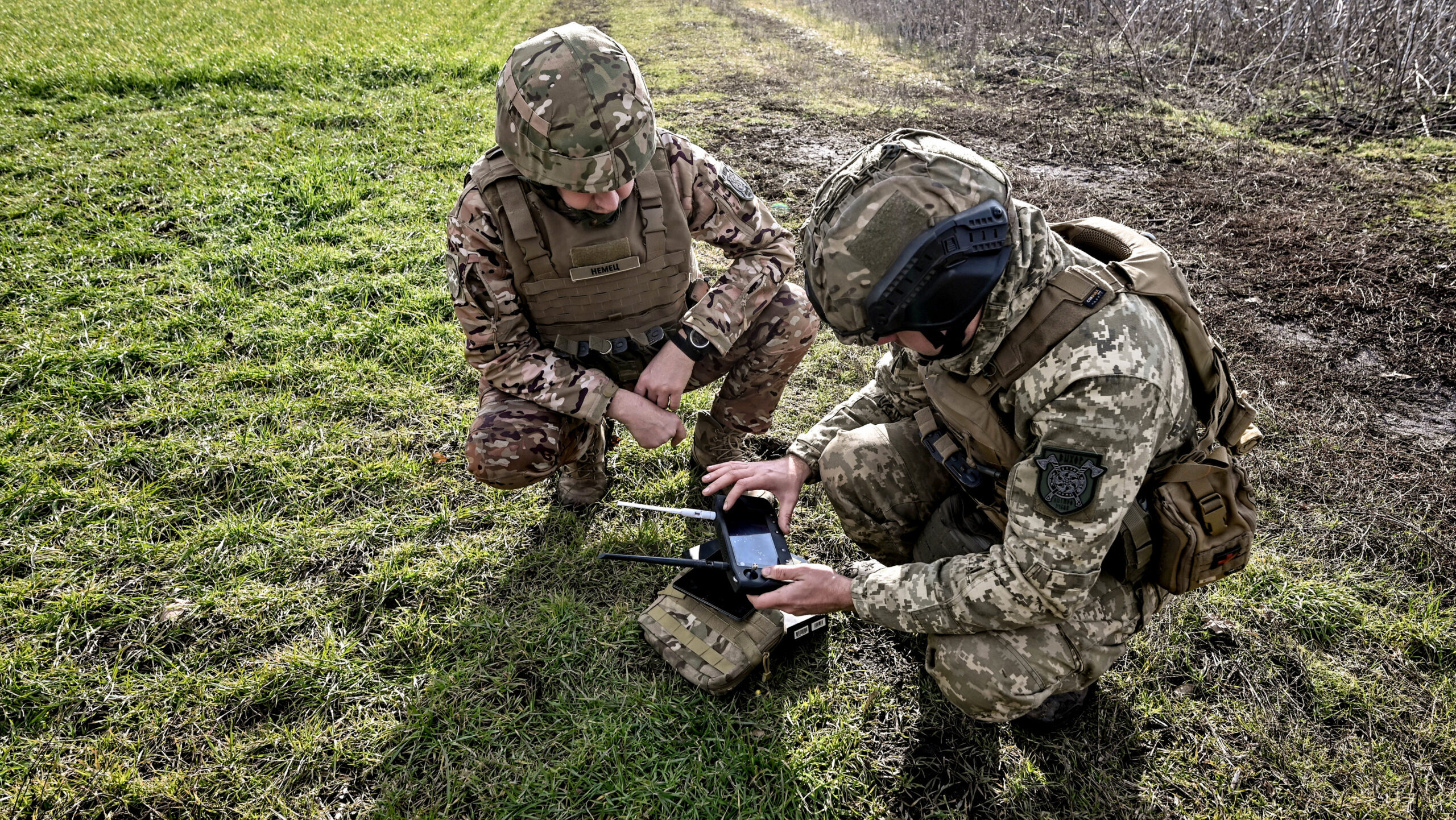
ZAPORIZHZHIA, UKRAINE – FEBRUARY 2, 2024 – Servicemen of the Vykhor Dnipro unmanned combat aerial complex platoon of the 108th Separate Territorial Defence Brigade show the launch of a Vampire drone, a Ukrainian unmanned combat aerial vehicle (UCAV) which is equipped with a thermographic camera, Zaporizhzhia region, southeastern Ukraine. (Photo credit: Dmytro Smolienko / Ukrinform/Future Publishing via Getty Images)
KYIV — Ukraine’s shoe-string wartime innovations have impressed and occasionally delighted observers both at home and abroad since Russia’s invasion in February 2022. But export controls levelled by the Ministry of Defense at the war’s outset have kept those innovations entirely at home.
The rules bar military equipment from leaving Ukraine, with very few exceptions, which are granted according to opaque practices. Now, one lawmaker wants that to change, in a move she and members of the nascent startup industry here hope could turn Ukraine into a global player on the weapons export stage.
In Ukraine, the only major buyer is the Ministry of Defense. It requires suppliers to show their spending on materials and productions, capping their profit margin at 25 percent over those outlays. Those contracts are, moreover, unreliable and, like the rest of the country, the ministry is also strapped for cash and doesn’t buy everything those producers are hoping to sell.
“Our Western allies are searching for weapons for Ukraine all over the world,” Halyna Yanchenko, a 36-year-old member of Ukraine’s parliament, told Breaking Defense. “Sometimes they fail to find enough ammunition — for example, missiles for air defense — and our private companies are doing their best to actually produce them in Ukraine, but they can only sell them to Ministry of Defense, which does not always have enough resources to purchase everything that is produced in Ukraine.”
Yanchenko believes these controls are snuffing out the young military tech industry and, counterintuitively, limiting their ability to produce for the front inside of Ukraine. She notes that “The Ukrainian budget has in generally has decreased a lot because we lost a lot of territories. We lost the most industrial parts of our country,” meaning new tech startups are struggling to get the government funding they need to actually grow.
RELATED: Inside Ukraine, startups try to edge Russia in the electronic warfare race
Letting in international sales would be one way to help spur investment in these firms, she says.
“Our joint efforts will help establish something like Silicon Valley in Ukraine because actually the Silicon Valley or the Bay Area also started as a place of military innovations,” says Yanchenko. “This is the time and place to actually come up with this innovation”
“I believe that there should be competition. Competition is always good, in any kind of sphere and processes. In the private sector, competition leads to innovations, better quality and price for the client and market,” she says, noting that the Ukrainian military would stand to gain from its local producers having more money in hand.
Post-Soviet Selloff
The argument for these export controls goes that Ukraine needs everything available to it. It is a sentiment steeped in history.
Ukraine is still kicking itself for giving up nuclear weapons in exchange for Western defense guarantees in the early 90s. The situation has allowed continuous nuclear blackmail from the Kremlin. And pre-war, Ukraine remained one of the world’s largest weapons exporters, largely based on the sell-off of old Soviet equipment — a process often plagued with corruption that liquidated stockpiles that the country today sorely misses. That regret is part of the context for the stringency of current export controls.
Ukraine’s weapons start-ups are slightly different. But it remains a touchy enough issue that most companies and organizations are in fact loathe to comment publicly on the desire to export.
In a statement to Breaking Defense, the State Service of Export Control of Ukraine noted “in recent years there has been a steady trend to an increase in entities applying for registration with the intent of obtaining authorization from the Cabinet of Ministers of Ukraine to export military goods.”
With the outbreak of the war, 2022 and the beginning of 2023, the office noted, were an exception. But the trend has since resumed.
Yanchenko says she is quietly organizing such companies into a working group that will lobby, among others, the Ministry of Defense.
As Yanchenko wrote on her Facebook page, “I know for a fact that there are outfits ready to work 24/7, but due to the absence of orders they’re operating at minimal capacity. Moreover I know many Ukrainian developers who give free equipment to the front from a part of their profits, but first that profit needs to appear.”
Yanchenko believes it is possible to provide the military with everything it is currently getting and more, by having it lay out a procurement list of what it will buy in advance of fiscal quarters or halves. Per her vision, Ukrainian producers shouldn’t sell anything abroad until those orders are full, but then they would be able to export surplus with caps at maybe a third or two-thirds of what they’re making. “But generally, there should be a market. There should be access to external buyers, buyers abroad,” she says.
Ukrainian drones have gotten the most attention, partially because many of them conveniently produce their own easily shareable video content, but the frontlines are full of clever fixes to cope with continuous shortages.
Yanchenko cites a recent trip to a special operations unit in Kherson who, armed with 3-kilometer mortars, were ordered to clear Russians from positions on islands in the Dnieper that were up to six kilometers away.
The unit stripped the shells and packed more powder in, working from literal garages, fulfilling the mission to the amazement of the commander who’s ordered it. “They joked, ‘our shells have extra motivation,’” recounts Yanchenko.
Dumb Money
In the US, defense tech startups have access to capital to help them scale up. That’s much harder to obtain for Ukrainian firms — another result of the restricted market.
“It’s really dumb to invest in Ukraine,” says Perry Boyle, who invests in Ukraine. “Your companies get air raids, you know, they’re operating in an active war zone. But the key reason is you only have one customer, which is the Ukrainian government.”
Boyle is an American, formally retired in Ketchum, Idaho, after decades of working in hedge funds. In February, he launched MITS Capital, one of the first miltech venture capital firms focusing on Ukraine to actually begin handing money over to local companies — largely out of his own pocket, he says, a move he once again describes as “dumb,” at least for the time being.
MITS took on an inaugural cohort of six drone start-ups in May, investing $100,000 in each of them and providing another $100,000 in resources for its accelerator. Like Yanchenko, Boyle is trying to change the situation so that cohort does not get stuck with a sole buyer.
“You have a batch-order single purchaser who will not let you have another customer — like, that’s dumb. I spend a lot of time talking with the ministries. If you want to attract real capital into your country to scale up warfighting production, you have to change this,” he says, claiming that the Ministry of Defense is the primary driver of the ban. “The problem is, it’s the army against every other ministry right now.”
The Ministry of Defense did not return requests for comment for this story.
Why would the military be against lifting the export ban, when it could provide much needed capitol from abroad? According to to Yanchenko, political fears play a big part.
“One of the main reasons why the Ministry of Defense is afraid to actually lift this ban is they are afraid that Western allies will judge them for it,” says Yanchenko. Her current campaign with Western allies in particular focuses on Washington, DC and the U.S. Department of Defense, who have sent the most weapons to Ukraine and have been most concerned about the country selling them off.
Weapons purchases around the world have skyrocketed in the past two years, driven by Russia’s war in Ukraine, Israel in Gaza, and spiking fears over China’s aggression in Taiwan and the South China Sea. For example, after several years of stagnation, US weapons exports rose by over 55 percent between 2022 and 2023 to hit a record $80.9B — in no small part driven by US manufacturers replenishing EU stocks of old equipment sent to Ukraine.
It’s a boom economy that, Yanchenko and others fear, is currently passing Ukrainian weapons start-ups by.
The Ukrainian policy is not formally a ban. It requires any local production to get special permission before selling abroad during wartime. The policy is just not to grant that permission.
That only applies to weapons manufacturing within Ukraine; those looking to sell abroad are left arranging EU or UK subsidiaries and outside production in factories owned by other firms. However, those set-ups undermine one of the key advantages of manufacturing in Ukraine: cost.
It’s also an inconvenient way of doing business at the best of times, but especially when males aged 25 to 60 — a demographic that includes most of the defense tech leadership — need to seek special permissions from the government to leave the country.
But the bigger worry is that such subsidiaries will be a prelude to full departures from Ukraine, much as many of Ukraine’s most successful civilian startups pre-war had to take their operations abroad.
“Nothing prevents it from happening right now,” says Boyle. “They should be creating a Silicon Valley for defense innovation.”
There are Western governments looking to integrate and encourage Ukrainian production, however. At the end of May, Denmark led eight EU nations to announce a push to integrate Ukraine’s producers into the EU’s defense industry and defense innovation programs, lamenting that “almost 80 percent of the defense equipment purchased by EU member states since Russia’s invasion of Ukraine and to this day has been purchased outside Europe.”
Two weeks later, Denmark became the first NATO country to invest publicly and directly in the Ukrainian weapons industry.
“The Ukrainian defence industry has developed and modernized the past few years, and the production capacity today is larger than Ukraine’s ability to purchase,” the Danish Ministry of Defense wrote in a statement to Breaking Defense. “For now, artillery, drones, armored vehicles and missiles are good examples of possible areas of cooperation.”
The Danish solution is to give money directly to the Ukrainian Ministry of Defense, who will then spend it on contracts with local manufacturers. There remains, however, no talk of changing the 25 percent profit cap for those manufacturers.
Meanwhile, major outside weapons makers have begun setting up their own factories in Ukraine.
Turkish drone maker Bayraktar has broken ground on a new facility in Kyiv Oblast that will, founder Haluk Bayraktar says, employ some 500 people. The firm did not respond to a request for comment as to whether drones produced in Ukraine would be for the Ukrainian or international market; while its drones were stars of Ukraine’s defense in the early days of the full-scale invasion, they have since fallen from favor as being ill-equipped to deal with Russian electronic warfare.
Northrop Grumman has also come out as the first major US weapons makers to set up manufacturing within Ukraine, publicly.
If these foreign firms are setting up shop internally, they will, in theory, be bound by the same rules as domestic producers. But it is at least suggestive that they see a future in which they will be able to manufacture within Ukraine and sell abroad.
